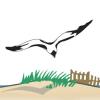Delaware farmers are pleading for relief from severe damage to their crops caused by an increasing deer population. Reports of damage are as high as $50,000 for a single farm. Delaware Farm Bureau has been working aggressively on this issue on behalf of all farmers since spring.
Delaware Farm Bureau leaders met with Delaware Secretary of Agriculture Michael Scuse and DNREC Secretary Shawn Garvin in July.
Farmers requested a program that would allow them to hunt on their farms with severe deer damage May through August - when the damage actually occurs - as a long-term solution.
DNREC's Division of Fish and Wildlife has two assistance programs for "situations where established deer hunting seasons do not provide adequate regulating of the deer population for commercial farming operations."
The Deer Damage Assistance Program, created in 1996, and the Severe Deer Damage Assistance Program, initiated in 2006, are designed to promote the harvest of antlerless deer.
DNREC further suggests farmers contact Delaware Master Hunters through Chris McKinley at 302-293-0064 or chrisdu850@gmail.com. He will contact Master Hunters to see how they can help.
DFB also met with legislators during the Delaware State Fair to share the extreme deer damage information and discuss introducing legislation in 2017.
Sen. Gary Simpson, R-Milford, Rep. Harvey Kenton, R-Milford, and Rep. Rich Collins, R-Millsboro, all participated.
The only real solution in Delaware would be to allow farmers to harvest deer in the summer, especially in June and July when they are doing the most damage. The harvest of deer between May 16 and Aug. 14 is prohibited in Delaware due to the occurrence of the fawning season.
In certain counties of Maryland, year-round hunting is allowed, under specific circumstances, by holders of deer management permits.
Farmers are not the only ones feeling the effects of so many deer. Non-farming residents are fed up with deer destroying their landscaping as deer lose natural forage areas to development.
Open space programs around suburban neighborhoods and restrictions therein also resulted in reduced hunting opportunities for deer, causing those natural areas to function as "deer refuges."
It should come as no surprise that deer love native plants, which has become a concern to the Task Force on Ecological Extinction. I serve on this task force.
The task force is required to study the issue of the local extinction of species in Delaware and recommend solutions to reverse the present course. Our report is due by Dec. 1, 2017.
The Delaware Deer Management Plan (2010-19) recognizes the problem: "Along with causing problems in urban and suburban areas, high deer numbers were causing significant damage to agricultural crops and too many of Delaware's forested ecosystems. Browse damage impacts forest regeneration and promotes the spread of invasive species and if left unchecked could alter our forest composition for years to come."
That plan also states: "Deer numbers are at an all-time high and deer overabundance is causing severe human-wildlife conflicts."
It includes an estimate that deer had an annual negative economic value of $2 billion, which included deer/vehicle collisions, damage to agricultural and timber productivity, damage to common household shrubs and gardens, and as a reservoir for Lyme disease.
A collision with a deer can be fatal. There were 876 deer collisions in Sussex County in 2015, according to a study by the Delaware State Police. Kent County experienced 391 collisions that year, and New Castle recorded 524 incidents.
Some data indicates Delaware has a deer collision rate in total of 1 in 148, ranking the state 28th in the nation. Average property damage claims in deer/vehicle collisions run about $4,000.
In the most recent figures (2011) from the federal Centers for Disease Control and Prevention, Delaware led the nation in lyme disease, which is spread by deer ticks, with more than 84 confirmed cases for every 100,000 residents. Delaware had 669 confirmed cases for 2012.
Provide Delaware Farm Bureau with facts, figures and photographs of deer damage on your farm. DFB will create a package to share with legislators and request legislation in 2018 to protect farmers and residents from continual damage. Proprietary information will be protected. Harvest mapping would be ideal, along with the hunting zone (found on DNREC's website) in which the field is located.
Email photos and information to carol.kinsley@defb.org, or mail them, or bring them to Delaware Farm Bureau, 3457 S. DuPont Highway, Camden DE 19934.
Kitty Holtz is president of the Delaware Farm Bureau.






















































